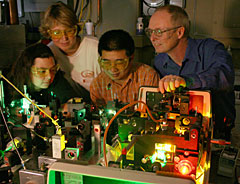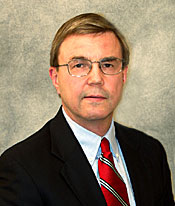Experiments Help Explain
‘Floppy’ Space Molecule
 |
| A research
team at JILA has developed a new method for making and analyzing
an unusual floppy molecule. Shown above with their experimental
apparatus are (from left) Chandra Savage, Erin Whitney, Feng
Dong, and David Nesbitt. Photo
by Jeff Fal, University of Colorado, Boulder
View
a high resolution version of this image.
|
A
laboratory
method developed for making and analyzing cold, concentrated samples
of a mysterious “floppy” molecule thought to be abundant
only in outer space has revealed new data that help explain the
molecule’s properties.
The advance,
described in the Jan. 6 issue of Science,* is a step
toward overcoming a decades-old challenge in chemistry—explaining
reactions that occur within very cold clouds among the stars,
and perhaps for developing new chemical processes. The paper combines
experiments performed by David Nesbitt and colleagues at JILA,
a joint institute of the National Institute of Standards and Technology
(NIST) and University of Colorado at Boulder, with theoretical
predictions made with Joel Bowman at Emory University in Atlanta,
Ga., and Anne McCoy at The Ohio State University in Columbus,
Ohio.
Most molecules
have a rigid three-dimensional (3D) structure. The subject of
the new study is “protonated” methane, which contains
one carbon atom and five hydrogen atoms, one of which is ionized,
leaving nothing but a proton (a particle with a positive charge).
The five protons from the hydrogen atoms scramble for four bonds
around the molecule as if playing a continuous game of musical
chairs. In the process, the molecule classically vibrates and
rotates in a bizarre manner, morphing between several 3D structures
with nearly identical energy levels. Chemists have spent decades
trying to explain why and how this occurs, a challenge that has
seemed insurmountable until recently.
Protonated
methane is a so-called “super acid.” This class of
molecule has been shown to be more than a million times more powerful
than conventional acids and is more effective in inducing reactions
that produce solvents and many other important industrial products.
Many theories
have been published on the puzzling behavior of this charged molecule
(or ion), but experiments must be done to match the ion’s
energy characteristics with its physical motions, and such data
are difficult to collect and understand. In particular, scientists
are interested in how the molecule absorbs different wavelengths
of infrared (IR) light, which provides clues about nuclear motion
and chemical bonds and structures. The JILA method generates concentrated
amounts of the ion at cold enough temperatures to simplify the
complex IR spectrum so it can be analyzed.
For further
information, see www.nist.gov/public_affairs/releases/floppy_molecule.htm.
*X. Huang,
A.B. McCoy, J.M. Bowman, L.M. Johnson, C. Savage, F. Dong, and
D.J. Nesbitt. 2005. “Quantum deconstruction of the infrared
spectrum of CH5+”. Science. Jan. 6.

Simulation Program Predicts Resistivity in Nanodevices
A
s nanoscale
circuits continue to shrink, electrical resistivity increases
in the wiring and limits the maximum circuit speed. A new
simulation program developed by researchers at the National
Institute of Standards and Technology (NIST) and George
Washington University (GWU) can be used to predict such
increases with greater input flexibility and model accuracy
than other methods. The software program is expected to
help the semiconductor industry design and test devices
more efficiently and with greater cost-effectiveness.
On
average, an electron can travel only 39 nanometers in pure,
bulk copper at room temperature before it is scattered by
thermal vibrations of the copper atoms. But, as the dimensions
of the wiring shrink, additional scattering by surfaces
and grain boundaries within the metal lead to undesirable
increases in resistivity. The NIST/GWU computer program,
described in a recent paper in Microelectronics Reliability,*
enables users to examine how these additional mechanisms
alter the resistivity of the thin, narrow metal lines that
make up the circuit wiring.
As
described in the journal article, NIST researchers used
the simulation program to demonstrate that, at critical
nanoscale dimensions, electron scattering from surfaces
and grain boundaries have effects that are interdependent.
This interdependence could not be predicted using methods
previously available. The finding has implications for both
achievable circuit speed and electrical measurements of
the dimensions of thin, narrow lines.
For
information about obtaining the software code and a forthcoming
NIST technical report on the project, contact Richard Allen
at (301) 975-5026 or richard.allen@nist.gov.
* A.E.
Yarimbiyik, H.A. Schafft, R.A. Allen, M.E. Zaghloul, D.L.
Blackburn. 2005. Modeling and simulation of resistivity
of nanometer scale copper. Microelectronics Reliability.
Posted online Dec. 19.
Media
Contact:
Laura
Ost, laura.ost@nist.gov,
(301) 975-4034
Helping
Small Firms Run Large Supply Chains
Big
manufacturing jobs, especially those in the defense industry that
involve management of extensive supply chains, often require resources
and expertise that many believe are beyond the capacity of small
and medium-sized enterprises (SMEs). Recent work by researchers
at the National Institute of Standards and Technology (NIST) and
colleagues at Pittsburgh’s Doyle Center for Manufacturing
Technology, however, demonstrates the capabilities of simulation
and visualization technologies for improving SME supply chain
expertise.
The proof-of-concept
test involved SME management of a 10-enterprise subassembly supply
chain for a major aircraft engine component. The Doyle Center
collected data for the simulation model often using questionnaires
and personal visits to suppliers. NIST and Doyle researchers then
adapted a commercial software program to build an accurate visualization
and analytical simulation model for the supply chain enterprise.
The finished
program allowed a small firm to know what would happen at any
given time during the flow of material through the chain. Data
inputs enabled it to use supplier production rates, inventory
numbers and shipment times for components. The model identified
prospective supply chain performance at “normal,”
“surge” (twice normal) and “mobilization”
(four times normal) production rates. When the program uncovered
potential bottlenecks in the supply chain, the team used the program
to evaluate potential impacts and to implement solutions to mitigate
risks and reduce costs.
NIST presented
a detailed description of the project at the 2005 Winter Simulation
Conference in December. “Stress Testing a Supply Chain Using
Simulation,” the NIST paper by Sanjay Jain and Swee Leong,
is available at http://www.informs-sim.org/wsc05papers/203.pdf.
Media
Contact:
John
Blair, john.blair@nist.gov,
(301) 975-4261


Updated
Federal Guide on Cryptography Available
In
an increasingly open environment of interconnected computer systems
and networks, security is essential to ensure that information
remains confidential, is not modified or destroyed and is available
when needed. To help federal agencies protect sensitive, but unclassified
information, the National Institute of Standards and Technology
(NIST) has updated a set of guidelines for selecting and implementing
cryptographic methods.
Originally
published in 1999, Guideline for Implementing Cryptography
in the Federal Government (NIST Special Publication 800-21-1)
is intended primarily for federal employees who design computer
systems and procure, install and operate security products to
meet specific needs. The publication is one of a series of key
standards and guidelines produced by NIST’s computer security
experts to help federal agencies improve their information technology
security and comply with the Federal Information Security Management
Act (FISMA) of 2002. FISMA requires all federal agencies to develop,
document and implement agency-wide information security programs
and to provide security for the information and information systems
that support the operations and assets of the agency. The act
called upon NIST to develop the standards and guidelines needed
for FISMA compliance.
The publication
is available at http://csrc.nist.gov/publications/nistpubs/index.html#sp800-21-1.
Media
Contact: Jan Kosko, janice.kosko@nist.gov,
(301) 975-2767


Quick Links
NIST
Summer Research Jobs, Applications Due Feb. 15
This summer
the National Institute of Standards and Technology (NIST) will
again provide about 125 full-time undergraduate research fellowships
for college students majoring in physics, chemistry, materials
science, engineering, mathematics and computer science. Supported
by the National Science Foundation, the program provides 12 weeks
of paid employment and gives young scientists and engineers an
opportunity to work in NIST research laboratories alongside some
of the world's leading experts in science and technology. Positions
are available in both Gaithersburg, Md., and Boulder, Colo., for
the time period, May 22 to Aug. 11, 2006.
Students must be recommended
by their departments and applications must be submitted from each
college or university as a group by Feb. 15. Students interested
in applying should contact the administrative office for their
departments as soon as possible for instructions.
In operation
since 1993 and known as the Summer Undergraduate Research Fellowship,
or SURF, the program offers a unique, hands-on learning experience.
Students work with mentors on NIST research projects using cutting-edge
technology. Other benefits include regular seminars held on the
NIST campuses throughout the summer on a broad array of current
science and technology topics and the opportunity to meet peers
from across the United States. A video that includes interviews
with past SURF student participants is available at www.surf.nist.gov/gallery.htm.
For more
information on the SURF program or to obtain a copy of the application,
please visit www.surf.nist.gov/surf2.htm
(Gaithersburg) or http://surf.boulder.nist.gov
(Boulder) or contact Anita Sweigert, NIST, 100 Bureau Drive, Stop
8400, Gaithersburg, Md. 20899-8400.
NIST
Appoints Hayes to Head Earthquake Program
 |
| John
(Jack) R. Hayes Jr. |
The
National Institute of Standards and Technology (NIST) announced
Jan. 10 that John (Jack) R. Hayes Jr. has been appointed director
of the National Earthquake Hazards Reduction Program (NEHRP) effective
Feb. 5, 2006. NEHRP is the federal government’s program
to reduce the risks to life and property from earthquakes. NEHRP
consists of four federal agencies: the Federal Emergency Management
Agency (FEMA), the National Science Foundation (NSF), the United
States Geological Survey (USGS) and NIST. Congress designated
NIST as the lead agency for NEHRP in 2004.
As director,
Hayes will provide overall program management, coordination and
technical leadership for NEHRP; strengthen program effectiveness
by facilitating implementation of earthquake risk mitigation measures;
and build and maintain effective partnerships with NEHRP program
agencies and stakeholders in industry, academia and government.
Hayes joins
NIST after serving since 1988 as leader of seismic and structural
engineering research at the U.S. Army Engineer Research and Development
Center’s (ERDC) Construction Engineering Research Laboratory
(CERL) in Champaign, Ill.
For further
information, see www.nist.gov/public_affairs/releases/director_nehrp.htm.
NIST
Names Hockert Chief of Weights and Measures
The
National Institute of Standards and Technology (NIST) announced
Jan. 10 that Carol Hockert has been selected as the new chief
of the NIST Weights and Measures Division. The division promotes
uniformity in U.S. weights and measures laws, regulations, and
standards to achieve marketplace equity.
Hockert,
who will join NIST on Feb. 20, is currently director of the Minnesota
Weights and Measures Division. She replaces Henry Oppermann who
retired July 1, 2005. Hockert previously served as a technical
expert for NIST’s National Voluntary Laboratory Accreditation
Program (NVLAP) and as a vice president of NCSL International
(formerly known as the National Conference of Standards Laboratories).
As chief
of the Weights and Measures Division, Hockert will work with the
National Conference on Weights and Measures (NCWM), and advise
its Board of Directors. NCWM is a professional organization of
state and local weights and measures officials and representatives
of business that works to “advance a healthy business and
consumer climate through fair and equitable weights and measures
standards.”
Hockert
also will oversee division programs that offer training for weights
and measures officials and laboratory metrologists, develop test
procedures for weighing and measuring devices, provide guidance
on weights and measures laws and regulations, provide NIST input
to the NCWM, coordinate U.S. input for international standards
for legal metrology, and develop and publish NIST reports for
weights and measures.
Further information
on the NIST Weights and Measures Division can be found at www.nist.gov/owm.

